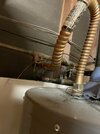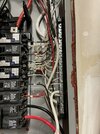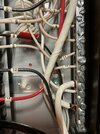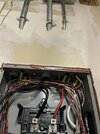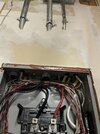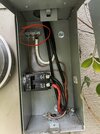You're thinking of separate structures with no other connections, same structure subpanels ground to main panel.Edit: Ok, I think I understand. The main panel is just the 125A breaker. I think the sub panel should have its own ground bond straight down to the ground rod, and no ground wire between the sub and main panels.
Welcome to Tesla Motors Club
Discuss Tesla's Model S, Model 3, Model X, Model Y, Cybertruck, Roadster and More.
Register
Install the app
How to install the app on iOS
You can install our site as a web app on your iOS device by utilizing the Add to Home Screen feature in Safari. Please see this thread for more details on this.
Note: This feature may not be available in some browsers.
-
Want to remove ads? Register an account and login to see fewer ads, and become a Supporting Member to remove almost all ads.
You are using an out of date browser. It may not display this or other websites correctly.
You should upgrade or use an alternative browser.
You should upgrade or use an alternative browser.
Mobile connector flashes 2x - “ground loss”
- Thread starter dohmahmigh
- Start date
OxBrew
Active Member
Is this separate structure or same structure?
In same structure, still need a separate ground, and the neutral bus is not bonded to the sub panel. Only difference is the ground can come from the main panel. Ground still can't connect to neutral anywhere except in the main service entrance panel.
In same structure, still need a separate ground, and the neutral bus is not bonded to the sub panel. Only difference is the ground can come from the main panel. Ground still can't connect to neutral anywhere except in the main service entrance panel.
Last edited:
Ok, @wwhitney will hopefully chime in here.Thanks y’all for the input so far. I’ve taken a few more pics of the set up.
1st pic is the main panel. It looks like the ground and the neutral are bonded as I see bare wire and white wire connected to the same bus. Is that right?
2nd pic shows two bare wires leaving the box. Left conduit goes straight to the ground and the right conduit turns towards the garage.
3rd pic shows where the right conduit in the 2nd pic ends but with a metal wire (painted in greyish color) sticking out and continues thru the wall into the garage
4th pic shows that greyish wire connected to a gas pipe.
Since I have extra 6awg wire left, i pulled out 3 of the wires from inside and connect them so it’s long enough for me to connect from the gas pipe to the ground bus in the subpanel.
But unfortunately same issue persists.
Do I need a bigger gauge wire to make that ground connection from the gas pipe to the subpanel ground bus?
Thanks y’all!
The vertical conduit below the meter probably connects to the ground rod.
There should be a separate insulated ground wire from the meter panel to the sub panel.
Sub panel neutral bar should not bond to sub panel. (Likely isn't currently)
Bonding the gas line is a recommended thing
Theoretically, if you have metal water piping (service), that would be bonded too.
There should be a separate insulated ground wire from the meter panel to the sub panel.
Sub panel neutral bar should not bond to sub panel. (Likely isn't currently)
Bonding the gas line is a recommended thing
Theoretically, if you have metal water piping (service), that would be bonded too.
I think I mixed things up earlier. The greyish wire from the outside isn’t tied to the gas pipe. As far as I can tell, it came into the garage and then went behind the wall. I also see a ground wire connected to the water pipe above the water heater (see new pic attached).Yeah.
So is the pic of the full panel with all the breakers a sub panel, maybe in the garage?
Sub panels need separate ground rods. Neutrals need to be not bonded to the box. (remove the special screw that electrically connects the neutral bus to the sub panel box)
The main panel SHOULD be bonded ground to neutral, that is the ONLY place they are bonded together, so that is correct.
Can you take a new pic of the sub panel, with the new ground bond?
Edit: Ok, I think I understand. The main panel is just the 125A breaker. I think the sub panel should have its own ground bond straight down to the ground rod, and no ground wire between the sub and main panels.
And gas lines absolutely do need to be bonded to water lines, usually at the water heater, just since they are close together. And water bonded to the ground rod, usually at the main panel.
Neither water or gas can be a substitute for a ground rod, there's no guarantee they are actually grounded. Could have a repair somewhere up stream with a section of plastic pipe, or not making good earth contact.
Best is to install 2 ground rods 6ft apart and bond them per code. It's easy.
There’s a vent then I could run a ground wire to the yard. Is the reco to just run a separate wire from the subpanel ground bus to the yard and tie it to the stake in the ground?
And yes you’re right the subpanel (very busy looking panel from my original box) is inside the garage.
Attachments
What does it mean to be separate or same structure?Is this separate structure or same structure?
In same structure, still need a separate ground, and the neutral bus is not bonded to the sub panel. Only difference is the ground can come from the main panel. Ground still can't connect to neutral anywhere except in the main service entrance panel.
Ideal is to have an electrician run a properly sized insulated ground from the subpanel ground bar to the meter neutral junction and ensure the subpanel neutral bar is not connected to the subpanel housing.I think I mixed things up earlier. The greyish wire from the outside isn’t tied to the gas pipe. As far as I can tell, it came into the garage and then went behind the wall. I also see a ground wire connected to the water pipe above the water heater (see new pic attached).
There’s a vent then I could run a ground wire to the yard. Is the reco to just run a separate wire from the subpanel ground bus to the yard and tie it to the stake in the ground?
And yes you’re right the subpanel (very busy looking panel from my original box) is inside the garage.
Regarding separate: if the meter and sub panel are mounted to the same structure then they are not separate (versus detacted garage).
stopcrazypp
Well-Known Member
It is not well defined in code, but generally means if it is in the same building or not. For example a shed that is completely detached from the house is generally considered a separate structure.What does it mean to be separate or same structure?
Separate structure?
An attached garage (which if I understood correctly is your case) where the main panel is even right on the other side of the wall, is considered the same structure (I see no reasonable interpretation otherwise).
As such you do not need a separate grounding rod, for the subpanel, AFAIK. The grounding rod is only for protection for things like lightning strikes, it will likely not solve your problem.
Your issue appears to be there is no direct ground connection between your main panel to your subpanel. It appears the only connection is via the (metal?) conduit between your main panel and subpanel.
Last edited:
wwhitney
Active Member
As to the problem in the OP, my general understanding (not specific to Tesla's mobile connector) is that the EVSE is doing a ground assurance test, in which it intentionally tries to pass a small current from hot to ground. If it finds the ground resistance too high, then it fails the ground assurance test. The high resistance ground typically still shows proper voltage measurements with a multimeter, unless you use one with a "low impedance" mode and check it in that mode.
To test this, if you have an incandescent light bulb and a socket with some pigtail leads, you can try testing the light bulb hot to neutral and compare it hot to ground. With a high resistance ground, the bulb won't light or will light more dimly than hot to neutral. Here the light bulb is just a low impedance tester.
As to the info provided, I didn't study it all carefully, but my questions are: what is the spatial relationship between the panel in the second picture and the panel in the first picture? Are there any intervening panels, or does power go directly from the former to the latter? What is the wiring method between them, i.e. what type of conduit? And in the first picture, the upper left conduit opening in the back, there's 3 black wires emerging from there that connect to the panel main lugs (one of which is taped white near its termination on the neutral bar on the right side); is there a 4th wire coming from that opening, that is somehow fully obscured?
All of the discussion about earthing (ground rods, water pipes, gas pipes, etc) is a side story and not actually relevant to the issue at hand.
Cheers, Wayne
To test this, if you have an incandescent light bulb and a socket with some pigtail leads, you can try testing the light bulb hot to neutral and compare it hot to ground. With a high resistance ground, the bulb won't light or will light more dimly than hot to neutral. Here the light bulb is just a low impedance tester.
As to the info provided, I didn't study it all carefully, but my questions are: what is the spatial relationship between the panel in the second picture and the panel in the first picture? Are there any intervening panels, or does power go directly from the former to the latter? What is the wiring method between them, i.e. what type of conduit? And in the first picture, the upper left conduit opening in the back, there's 3 black wires emerging from there that connect to the panel main lugs (one of which is taped white near its termination on the neutral bar on the right side); is there a 4th wire coming from that opening, that is somehow fully obscured?
All of the discussion about earthing (ground rods, water pipes, gas pipes, etc) is a side story and not actually relevant to the issue at hand.
Cheers, Wayne
@OxBrew yes this is the same structure. I do not have a detached garage. you mentioned "remove the special screw that electrically connects the netrual bus to the sub panel box" - i'm not quite sure i can find such a screw. is it this green one? it looks like it's connected to the ground bus though (??)Is this separate structure or same structure?
In same structure, still need a separate ground, and the neutral bus is not bonded to the sub panel. Only difference is the ground can come from the main panel. Ground still can't connect to neutral anywhere except in the main service entrance panel.
Attachments
@stopcrazypp thanks for explaining same vs separate structure. We don't have a detached garage so yes it's the same structure. Yes I don't believe a direct ground connection exists between my main and the subpanel. Here's a picture of the metal conduit (left side) that carries the 3 fattest black wire to the subpanel thru the top leftmost opening.It is not well defined in code, but generally means if it is in the same building or not. For example a shed that is completely detached from the house is generally considered a separate structure.
Separate structure?
An attached garage (which if I understood correctly is your case) where the main panel is even right on the other side of the wall, is considered the same structure (I see no reasonable interpretation otherwise).
As such you do not need a separate grounding rod, for the subpanel, AFAIK. The grounding rod is only for protection for things like lightning strikes, it will likely not solve your problem.
Your issue appears to be there is no direct ground connection between your main panel to your subpanel. It appears the only connection is via the (metal?) conduit between your main panel and subpanel.
Attachments
OxBrew
Active Member
Nope, not that one.
And don't remove anything until you know the sub panel is grounded (bonded) properly.
At this point, I'd get an electrician to sort it out. Should not take too long, and could save a lot of headache if something went wrong sometime. Plus, would get your MC working.
I mean, it's probably fine, the conduit is probably a ground path, but they can be flakey if they are not really tight.
And don't remove anything until you know the sub panel is grounded (bonded) properly.
At this point, I'd get an electrician to sort it out. Should not take too long, and could save a lot of headache if something went wrong sometime. Plus, would get your MC working.
I mean, it's probably fine, the conduit is probably a ground path, but they can be flakey if they are not really tight.
@wwhitney thanks the input and questions. I'll try my best to answer your questionsAs to the problem in the OP, my general understanding (not specific to Tesla's mobile connector) is that the EVSE is doing a ground assurance test, in which it intentionally tries to pass a small current from hot to ground. If it finds the ground resistance too high, then it fails the ground assurance test. The high resistance ground typically still shows proper voltage measurements with a multimeter, unless you use one with a "low impedance" mode and check it in that mode.
To test this, if you have an incandescent light bulb and a socket with some pigtail leads, you can try testing the light bulb hot to neutral and compare it hot to ground. With a high resistance ground, the bulb won't light or will light more dimly than hot to neutral. Here the light bulb is just a low impedance tester.
As to the info provided, I didn't study it all carefully, but my questions are: what is the spatial relationship between the panel in the second picture and the panel in the first picture? Are there any intervening panels, or does power go directly from the former to the latter? What is the wiring method between them, i.e. what type of conduit? And in the first picture, the upper left conduit opening in the back, there's 3 black wires emerging from there that connect to the panel main lugs (one of which is taped white near its termination on the neutral bar on the right side); is there a 4th wire coming from that opening, that is somehow fully obscured?
All of the discussion about earthing (ground rods, water pipes, gas pipes, etc) is a side story and not actually relevant to the issue at hand.
Cheers, Wayne
1. spatial relationship between the main (2nd pic) and the subpanel (1st pic) - no intervening panels. power goes directly from the main to the subpanel (see 1st pic attached with the metal conduit that carries 3 black wires into to the subpanel)
2. what type of wiring method between them - metal conduit (see the same pic in #1 above)
3. upper left conduit opening in the back - only 3 black wires. no 4th wire so it does not look like there's a ground connection from the main panel to the subpanel
Attachments
Nope, not that one.
And don't remove anything until you know the sub panel is grounded (bonded) properly.
At this point, I'd get an electrician to sort it out. Should not take too long, and could save a lot of headache if something went wrong sometime. Plus, would get your MC working.
I mean, it's probably fine, the conduit is probably a ground path, but they can be flakey if they are not really tight.
@OxBrew when you say "the conduit is probably a ground path" - you mean the metal conduit that's carrying the 3 black wires from the main to the subpanel is serving as the ground connection between the main and subpanel?
OxBrew
Active Member
Most likely, yes. But it needs to be checked. I've seen them get loose, or never really tight in the first place. See post #26 above. You need to do exactly that, and if you don't know how, get an electrician. Couple hundred bucks at most, and it will be fixed properly.
Edit: actually, looking again, it looks like that green screw is where the neutral would be bonded, into the empty hole in the bus, so it actually looks correct. So all you probably need is a proper ground to the sub panel.
Even easier. Still would get an electrician to check it. Loose neutrals can also cause a lot of flakey weird stuff, and they would check for that too.
Edit: actually, looking again, it looks like that green screw is where the neutral would be bonded, into the empty hole in the bus, so it actually looks correct. So all you probably need is a proper ground to the sub panel.
Even easier. Still would get an electrician to check it. Loose neutrals can also cause a lot of flakey weird stuff, and they would check for that too.
stopcrazypp
Well-Known Member
You have a Siemen's panel right? If so, that screw is used to connect a neutral bonding strap (as pictured below) to the ground. Given you don't appear to have one there (the strap appears removed), your subpanel should already have the neutral isolated from the ground.@OxBrew yes this is the same structure. I do not have a detached garage. you mentioned "remove the special screw that electrically connects the netrual bus to the sub panel box" - i'm not quite sure i can find such a screw. is it this green one? it looks like it's connected to the ground bus though (??)

Grounding Hardware - Siemens panels
@stopcrazypp I have a murray panel but i guess it's the same as Siemen since they bought Murray. you are right, there's no strap connecting the green screw to one of the holes in the neutral bus.
@OxBrew @mongo got it. the circled in the attached picture is the "meter neutral junction" correct?
@OxBrew @mongo got it. the circled in the attached picture is the "meter neutral junction" correct?
Attachments
stopcrazypp
Well-Known Member
Yes, that's what I've been trying to say too. That is why your multimeter still measures a voltage to ground, but it could still be an iffy connection (which is probably why it failed the mobile connector test).@OxBrew when you say "the conduit is probably a ground path" - you mean the metal conduit that's carrying the 3 black wires from the main to the subpanel is serving as the ground connection between the main and subpanel?
A ground wire would be the common way to do a ground connection between the main and subpanel, but a grounding bushing that I mentioned earlier may help create a better connection with the conduit if that is your only option. This ensures your conduit has a better connected to the grounding bus bar via wire (instead of through conduit clamp connection then through your panel). You can see an example in your main panel (circled in red):
Not an electrician, but from what I can find, relying on EMT (metal conduit) as the ground connection is generally allowed as long as the run is continuous, although you may have to consult your local code to see if it is allowed in your situation. As others mentioned however, probably consulting with an electrician is the best bet. Messing with the main panel can be quite dangerous if you don't know what you are doing, plus you may screw something up and leave your whole house without power.
It's probably best also to check your 14-50 outlet as suggested earlier before doing anything else. It could be a simple bad connection there. Also making sure your 14-50 adapter is fully plugged into the mobile connector (I remember reading sometimes some people don't plug it in all the way), as well as 14-50 fully plugged into the outlet (also have read some people not doing that because it takes more force than a typical outlet).
And
Especially since subpanel has concentric rings left in the knock out so there are only 2 little connection points:

We can't see what going on with the meter side of things, but it looks like to only potential ground path is the threads of the 4 screws:

This.A ground wire would be the common way to do a ground connection between the main and subpanel, but a grounding bushing that I mentioned earlier may help create a better connection with the conduit if that is your only option. This ensures your conduit has a better connected to the grounding bus bar via wire (instead of through conduit clamp connection then through your panel). You can see an example in your main panel (circled in red):
Especially since subpanel has concentric rings left in the knock out so there are only 2 little connection points:
We can't see what going on with the meter side of things, but it looks like to only potential ground path is the threads of the 4 screws:
Yes, that is the single bonding point.@mongo got it. the circled in the attached picture is the "meter neutral junction" correct?
SageBrush
REJECT Fascism
I may be missing it, but I don't see a ground feed to the breaker panel.
Do you mean from the main service panel to the sub-panel,
Or from the 14-50 receptacle to the sub-panel ?
I think I can see the latter
Yeah. Main/meter to the subpanel.Do you mean from the main service panel to the sub-panel,
Or from the 14-50 receptacle to the sub-panel ?
I think I can see the latter
Similar threads
- Replies
- 17
- Views
- 429
- Replies
- 9
- Views
- 505
- Replies
- 44
- Views
- 2K
- Replies
- 5
- Views
- 585



